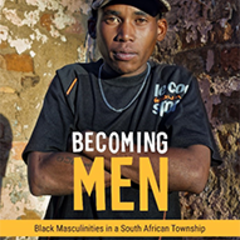Performing Masculinities and Class in Contemporary India and South Africa

Recently I had the pleasure of interviewing Professor Malose Langa from the University of Wits for our project about gendered violence and urban transformations in South Africa and India. I discussed with him his new book entitled ‘Becoming Men: Black Masculinities in a South African Township’ which came out in April this year. The book is based on 12 years of longitudinal research in Alexandra township with young men and is a nuanced mapping of masculinities, changing gender relations, as well as men’s anxieties and aspirations whilst living in a dynamic township lifeworld. In discussion with Prof. Langa I had several thoughts about the many parallels and differences amongst masculinities in his work and my own research on middle-class masculinities in India.
One comparative dynamic that struck me was about the role of gender and class operating in our two very different field sites. In the South African context, dating and sexual relations with women are widely encouraged and socially sanctioned for young men by their families, and men are relatively free to ‘choose’ their partners. However in India, young men’s sexualities are strictly policed and monitored by their families and are only encouraged through institutions of arranged marriage. These different gender orderings, including their many caveats, pose interesting questions for looking at how young men perform their masculinities and sexualities and what localised forms these take.
In the context of the poor and working class township of Alexandra, Prof. Langa finds that young men labelled as ‘sex jaro’ engage in sex with multiple sexual partners, boasting about their sexual conquests to other men and are free to ‘choose’ women to date and marry. Langa finds that in the sexual exploit of ‘sex jaro’ men in Alexandra, questions about consent are difficult to navigate and women are often coaxed and even coerced into sex. But at the same time, sexually satisfying women is also important for ‘sex jaro’ men for fear that women may go ‘elsewhere’ if the young men are not able to sexually satisfy them. In all male groups within the township, young men exchange tips on sexually satisfying women with suggestions on ‘sexual massaging’ and other tried and tested tips. As Langa points out, ‘sex jaros’ take great pride in being ‘good in bed’ and failure to sexually satisfy a woman becomes a marker of a failed masculinity for them. At the same time, within the urban context of the township, the ‘sex jaros’ lament the fact that older wealthier men with cars and material possessions woo women from the townships and some women ‘choose’ to engage in relationships with such older men. This heightens the economic, social and cultural anxieties experienced by poor and working-class black men in Alex who struggle to find jobs, often lack qualifications and have various stigmas attached around living in townships. This interesting dynamic raised several questions in my mind about the role of class in the performance of masculinities and about men’s relationships with women.
When thinking about these classed and gendered dynamics in the case of my own research on middle class youth masculinities in India, several interesting parallels and differences emerge which I am trying to think through. Firstly, young Indian men in my research were caught up within the pressures and obligations of arranged marriages and were never free to ‘choose’ sexual partners. This meant that all their sexual and romantic relations with their girlfriends occurred clandestinely and away from the familial gaze. I also found that the ‘middle class’ status of my informants meant that reproducing social and classed status was an important anxiety for them and they only wanted to date appropriately classed women. Young middle-class men are anxious about doing only ‘high status’ and ‘white-collar’ jobs in order to mark their difference from poor and working classes in the city. At the same time, such middle class men looked down on working class and poor men living in the many informal settlements in Delhi as being ‘hypersexual’ and not ‘cultivated’. I also found it particularly striking that amongst my informants, sexually satisfying women was never a major concern and sex was conceptualised only for their own masculine satisfaction. I found that middle class men emphasised markers of social status, appropriate consumption and being ‘refined’ men, rather than being sexually gifted in the way Langa’s poor and working class men seek to perform their masculinities. However I did find that these relatively affluent men would often coerce women to perform sexual acts on them, behind metro stations or in abandoned shopping malls, and sometimes even blackmailed girlfriends using photos and screenshots of private conversations.

In this way, thinking through the lens of performing masculinities and class, some complex parallels and differences seem to emerge for me in comparing and contrasting my own work and thinking with Prof. Langa’s work in Alex. It raises to my mind several questions on how we think about comparing two different contexts and the values and challenges of such comparative thinking? How do we preserve the particularities of the local whilst also not obscuring the transnational forces of patriarchy or capital? Also, what role does class play in activating masculine anxieties, affects, aggressions and aspirations and how do these emerge in the crosshairs of intimacy, violence and urban transformations?
By Shannon Philip
7th September 2020
Image Top: Jurien Huggins on Unsplash.
Image Bottom Right: Wits University Press
